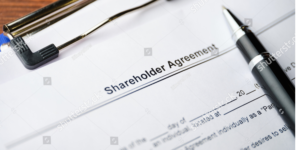In the lifetime of any private limited company, you will need to make important decisions. Shall we appoint a new director? Do the articles of association need to be updated? Is it time to close the company down? These decisions need to be made the right way. And this is where a general meeting comes in.
In this post, we’ll answer your questions about the role of general meetings in running a UK limited company. Let’s get started.
Key Takeaways
- General meetings are formal meetings of a company’s shareholders or guarantors (aka its members).
- These meetings are optional for private companies but compulsory for public companies.
- Annual general meetings (AGMs) are held once per year, while extraordinary general meetings (EGMs) are those held at any time between AGMs.
What is a general meeting?
A general meeting is a formal meeting of a company’s members. The members are the shareholders or guarantors who own or control the business. General meetings are sometimes called shareholders’ meetings in a company limited by shares. These meetings may be:
- annual general meetings (AGMs), which are scheduled once per year to discuss routine business affairs
- extraordinary general meetings (EGMs), which can be called at any time to address urgent or significant matters arising between AGMs
At a general meeting, members discuss important company affairs and make decisions through resolutions. Resolutions are voted on by the members via a show of hands or poll in accordance with their voting rights.
While these official meetings are optional for private companies, public limited companies must hold an AGM annually. However, all such meetings (optional or compulsory) must adhere to the rules set out in the Companies Act 2006 (CA 2006).
- What is a private limited company?
- What is a public limited company?
- A guide to keeping meeting minutes
They require a chairperson (usually a director, company secretary, or member), and meeting minutes should be kept. If a chairperson has not been elected before the meeting, the first piece of business at the meeting should be to appoint one.
As we’ll cover in more detail shortly, the general meeting is not compulsory. So, if you run a limited company by yourself (i.e. you’re the sole director and shareholder), whilst you could theoretically still hold a general meeting, this isn’t required.
It is important to stress that a one-person company still needs to record any decisions made, and these should be kept with the company records.
Who can attend a general meeting?
A general meeting is a members’ meeting, but certain non-members may also be entitled to attend. It’s important to check the articles of association and any shareholders’ agreement to determine the rules and restrictions for attending general meetings.
Company members
In many companies, every shareholder or guarantor can attend and vote at general meetings. However, it depends on the rights attached to each member’s shares (in a company limited by shares) or class of membership (in a company limited by guarantee).
Shareholders may not have the right to attend general meetings if they only have non-voting shares. Similarly, guarantors may not be permitted to attend if their membership class is non-voting.
Shareholder proxies
A shareholder proxy is a person who is authorised to act on behalf of a shareholder in their absence. Once appointed, they can attend general meetings and vote on the shareholder’s behalf—subject to any restrictions imposed by the shareholder or company.
The rules on proxies are set out in section 324 of the Companies Act 2006, which states that:
- A company member is entitled to appoint another person as his proxy to exercise all or any of his rights to attend, speak, and vote at a company meeting.
- In the case of a company having a share capital, a member may appoint more than one proxy in relation to a meeting, provided that each proxy is appointed to exercise the rights attached to a different share or shares held by him or (as the case may be) to a different £10, or multiple of £10, of stock held by him.
- A proxy must vote in accordance with any instructions given by the member by whom the proxy is appointed.
Corporate representatives
A corporate representative is an individual appointed to act on behalf of a corporate member (e.g. a company that holds shares in another company). In a company with corporate members, authorised corporate representatives may attend, speak, and vote at general meetings on behalf of those corporations.
Auditors
Under section 502 of the CA 2006, the auditor of a company is entitled—
(a) to receive all notices of, and other communications relating to, any general meeting which a member of the company is entitled to receive
(b) to attend any general meeting of the company, and
(c) to be heard at any general meeting that he attends on any part of the business of the meeting that concerns him as auditor.
If the auditor is a firm, it may authorise a corporate representative to attend or be heard at a meeting on its behalf.
Directors
The Companies Act 2006 gives directors the statutory right to notice of general meetings. Under the Model articles of association, the board of directors of a company also have the right to attend general meetings.
In some companies, members may alter the articles to restrict the right of directors to attend. However, since directors are responsible for running the company, their attendance can be beneficial. This allows members to review their performance, ask questions, and discuss any issues or future strategies.
What decisions can be made at a general meeting?
The general meeting is the domain of the shareholders. So, as you would expect from a meeting between the business owners/stakeholders – it is used to make significant decisions that will impact the company.
Decisions that can be made at a general meeting include (but are not limited to) the following:
- Allotting, transferring, and removing shares
- Appointing and removing directors
- Appointing and removing secretaries
- Approving large loans and contracts
- Changing the company name
- Creating or amending a shareholders’ agreement
- Updating a director’s duties
- Updating the articles of association
- Winding up the company
Who can call a general meeting, and how should it be organised?
Directors typically call general meetings. However, any shareholder holding at least 5% of the company shares can request that one be called if they believe it is necessary.
A director should notify the shareholders once a general meeting has been called. This notice can be delivered via post or email and must include the date, time, and location of the meeting, as well as the details of any proposed resolutions that will be discussed at the meeting.
In instances where a special resolution is being proposed, the full text of the special resolution needs to be included.
There are criteria in place regarding when the general meeting needs to be organised. It’s essential that the director:
- Gives shareholders at least 14 days’ notice
- Ensures the general meeting is called within 21 days of it being requested
- Ensures the general meeting is scheduled no later than 28 days after it is requested
If a meeting has been organised with a ‘short notice period’ (less than 14 days), any shareholder with more than 10% of the company shares has the power to stop it from going ahead.
How does voting work?
Decisions at a general meeting are made when votes are cast on ordinary and special resolutions.
These votes are normally conducted via a show of hands, but a poll can be requested instead. This can be requested by any shareholder with at least 10% of the company shares, any two shareholders, a director, or the chairperson.
It is common for a poll to be used after a show of hands if the show of hands was unsuccessful in obtaining a clear result for the resolution in question.
With a show of hands, the number of shares the shareholder holds is redundant (one shareholder equals one vote). On the other hand, with a poll, each shareholder has one vote for each share they hold.
An ordinary resolution requires a 50% majority to be passed, while a special resolution requires a 75% majority.
Only shareholders who hold shares with voting rights can vote on resolutions (regardless of the voting method used). If any proxies are present, they should have the exact same voting rights as the shareholder they represent.
What should be included in the meeting minutes?
Even if you’re the only person in your company, you must keep minutes for all of your general meetings. Not only is this a statutory requirement, but it may also come in useful if there are any internal or external disputes in the future.
Your general meeting minutes need to include the following information:
- Company name, number, and registered office address
- Date, time, and location of the meeting
- List of attendees
- List of proxies and who they are representing
- Proposed ordinary resolution(s), the result, and who voted for/against it
- Proposed special resolution(s), the result, and who voted for/against it
- Queries raised
- Any other business that was discussed
- Closing remarks
If your company has a secretary, they will normally keep the minutes. If no secretary is appointed, anyone else in the company—such as a director or shareholder—who is deemed suitable can take on the job.
Once written up, minutes should be distributed to all attendees and stored for at least 10 years at the company’s registered office (or SAIL address if one has been elected).
How many people must attend a general meeting for it to be valid?
The quorum for a general meeting, this being the minimum number of people who must be present for the meeting to be valid and for any resolutions to be passed, is two shareholders. This is unless this has been changed in the articles of association or if a company only has one shareholder.
This shouldn’t be confused with the minimum number of people required to get a resolution passed (this can be one).
Example:
- A company has two shareholders, both of whom are present at the general meeting. Therefore, the general meeting is valid.
- Shareholder A holds 51% of the company shares, and Shareholder B holds 49% of the shares.
- Through a poll, Shareholder A votes in favour of the ordinary resolution, and Shareholder B opposes this.
- Because two shareholders are present, the resolution is passed. This is valid because two shareholders were present, even though only one voted in favour of the resolution.
Do all shareholders need to be in the same room for a general meeting to go ahead?
No, the model articles for private limited companies (used by the majority of companies) imply that a general meeting can be held remotely: “In determining attendance at a general meeting, it is immaterial whether any two or more members attending it are in the same place as each other.”
So, unless the articles have been amended (this can be done before or after a company has been formed), you are free to conduct an AGM or EGM in any format. This means you can hold:
- physical general meetings, with everyone attending in person
- virtual general meetings, with all individuals attending via electronic means only (e.g. Teams)
- hybrid meetings, with some people attending in person and others dialling in from other locations via teleconference or videoconference
Be sure to check the company’s articles of association to find out which formats of general meetings are permitted.
Are they compulsory?
Yes and no. In most cases, they are not unless the company’s articles of association state that they are (the model articles do not state this).
However, a general meeting is compulsory if the removal of a company director or an auditor is being discussed. This would then need a special resolution to be voted on at a general meeting.
Other than this, most decisions that can be made at a general meeting can also be taken care of with a written resolution. As the name would suggest, a written resolution enables members (with voting rights) to vote and resolutions to be passed in writing.
Both ordinary and special resolutions can be taken care of with a written resolution.
So there you have it…
Communication is fundamental to the successful running of a limited company. Whilst a general meeting may be considered a nuisance, it provides a useful platform for members to come together and discuss the business in a proactive environment.
We hope you have found this post helpful.
Please comment if you have any questions regarding general meetings or anything else associated with starting and running a limited company.
Please note that the information provided in this article is for general informational purposes only and does not constitute legal, tax, or professional advice. While our aim is that the content is accurate and up to date, it should not be relied upon as a substitute for tailored advice from qualified professionals. We strongly recommend that you seek independent legal and tax advice specific to your circumstances before acting on any information contained in this article. We accept no responsibility or liability for any loss or damage that may result from your reliance on the information provided in this article. Use of the information contained in this article is entirely at your own risk.














Join The Discussion
Comments (10)
We are a small Freehold Company where the 4 Leaseholders own a 25% share of the Freehold Company and are also Directors . One of the previous leaseholders ( now deceased ) applied to the Tribunal to appoint a manager who is now managing the property . We as Directors believe we can now manage the property ourselves with a few changes to the lease regarding services charges ( at present it’s not fit for purpose) We want to have an EGM with a few resolutions for these amendments to take place . Do we have to involve the Tribunal Appointed Manager in the EGM
We are hoping that by amending the lease we can show the Tribunal that we are genuinely serious about managing via an RMC again and thus terminate the Managers tenure
Hi Angie,
Thank you for your comment!
If your company has adopted the Model Articles of Association or if your Articles allow for it, generally a director can be appointed via an ordinary members resolution i.e. if a shareholder has more than 50% of the voting weight then they would be able to appoint a director. Please note that most Articles (including the Model Articles) also allow for an appointment to be made via a decision of the directors.
Kind regards,
The 1st Formations Team.
If items at an AGM require voting majorities in excess of a bare maximum does that have to be stated on the Agenda?
Dear John,
Thank you for your kind comment.
We’re not aware of any specific requirement to state the required voting thresholds for resolutions on a general meeting notice, although a company may wish to do so, particularly if they differ from the usual voting thresholds required. All resolutions should be labelled as being ordinary or special, which itself normally denotes the threshold required for the resolution to pass (Unless the company has set a higher threshold in its articles of association, etc.).
Kind regards,
The 1st Formations Team.
If shareholders in a private limited company exercise their Article 303 right to require directors to call a general meeting, and the general purpose of the meeting is to call the directors to account concerning a collective breach of financial care and diligence, can the shareholders insist that one of them chairs the meeting?
Thank you for your kind comment.
Unfortunately as we are not regulated to provide legal advice, we are unable to provide advice on specific scenarios. We would recommend contacting a solicitor for further assistance.
Please accept our apologies for any inconvenience caused.
Kind regards,
The 1st Formations Team
Can shareholders who didn’t attend the meeting request access to the minutes of the meeting including list of attendees?
Can the 5% share ownership threshold to call a General Meeting be made up by more than 1 shareholder ?
Many Thanks
Thank you for your comment, Sayed.
1. Section 358 of the Companies Act 2006 states shareholders have the right to inspect minutes of General Meetings.
2. The 5% can be made up of more than one shareholder.
Kind regards,
The 1st Formations Team
what if I pass a resolution and it was seconded by a board member and no objection was raised by anyone but clarification was required by chairman and manger does not passes than what is the result
Thank you for your kind enquiry, Veena.
In the first instance, you would need to check your company’s articles of association for any relevant provisions relating to the passing of resolutions and any disputes that might arise.
We are assuming that by “what if I pass a resolution” this means you are a member of a company whose votes were enough to pass a resolution themselves, and that you did so. On the face of it, if a resolution has been passed then it is not clear from your comment as to how (and the reason) that said resolution has been “withdrawn”.
Additionally, it is unclear as to what is meant by a resolution being “seconded by a board member”. As a general rule, directors are not normally entitled to vote on shareholder resolutions, unless they happen to be a shareholder also (see Part 13 of the Companies Act 2006 for more information).
Further, it is unclear what is meant by “clarification was required by the chairman and manager”. In some cases, the chairperson of a general meeting is able to make certain adjustments to resolutions. For example, under the model articles of association, a special resolution can be amended by ordinary resolution if the chairperson of the meeting proposes the amendment at the same general meeting and the amendment itself only corrects the grammar and does not materially change the point of the resolution.
We trust this information is of use to you.
Kind regards,
The 1st Formations Team